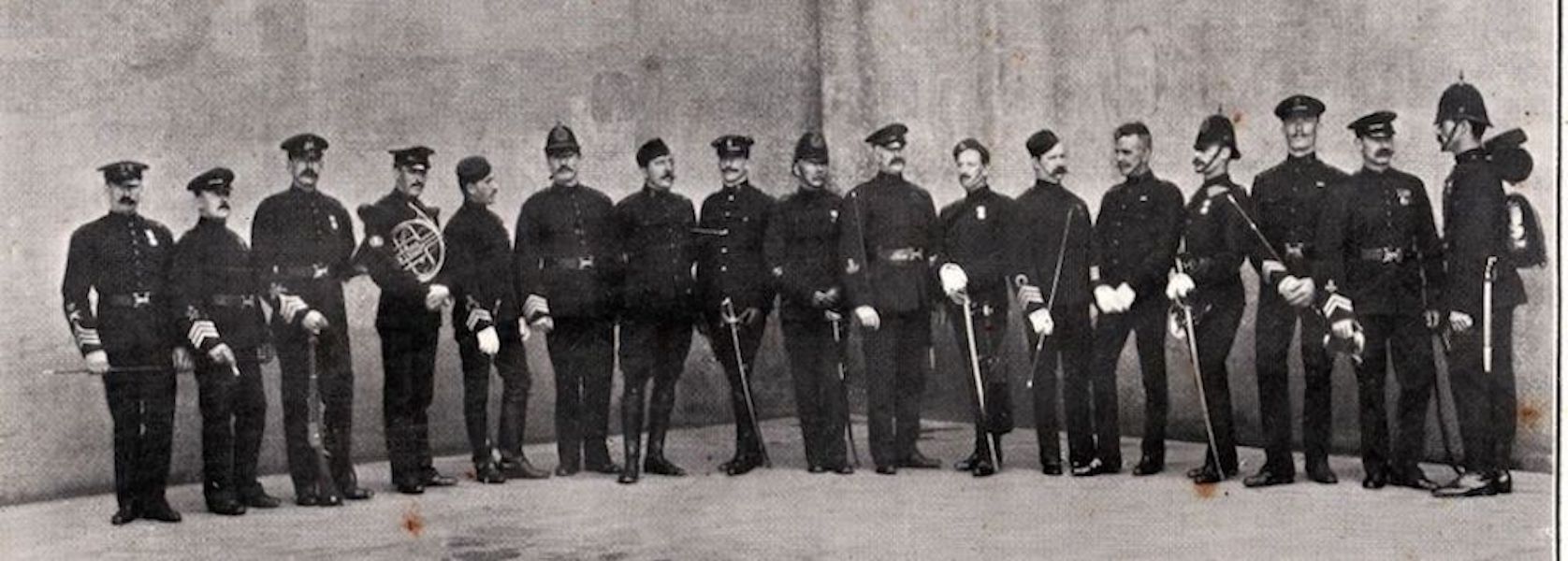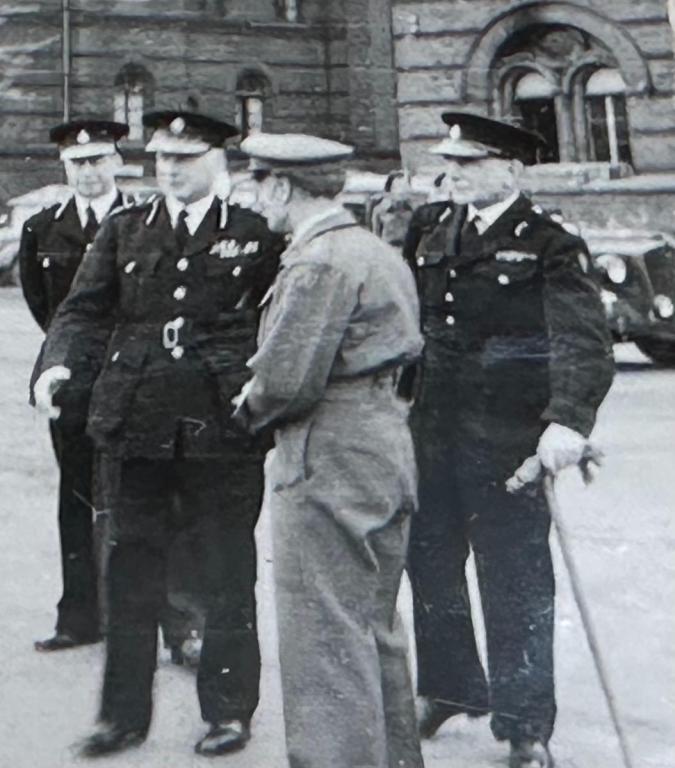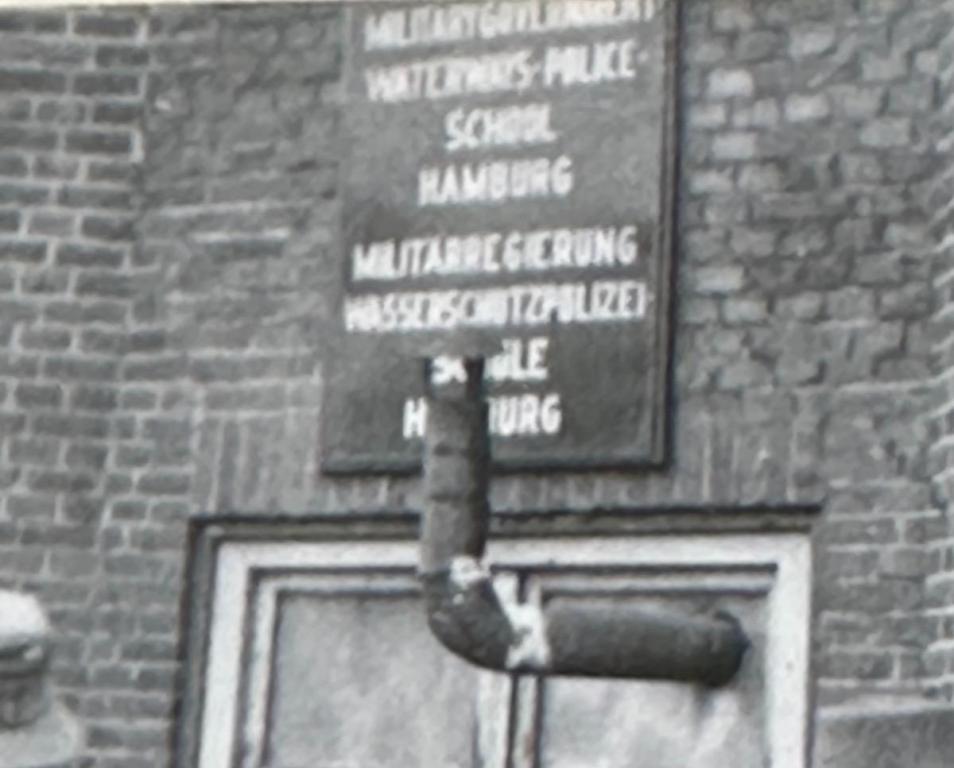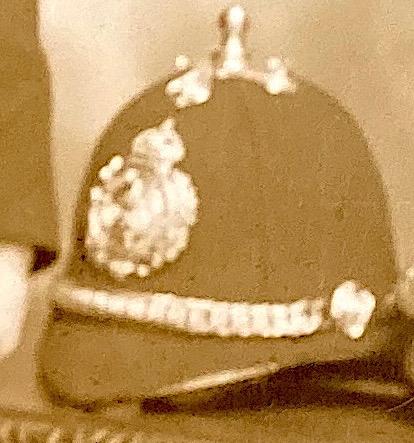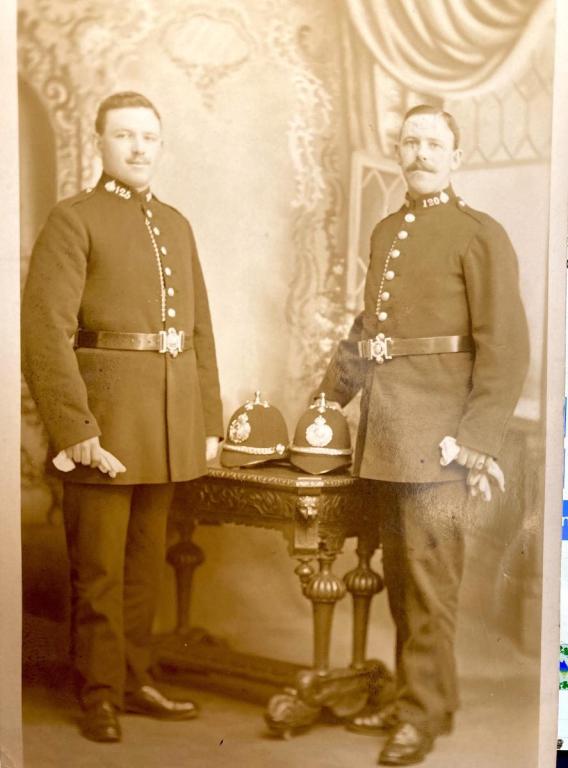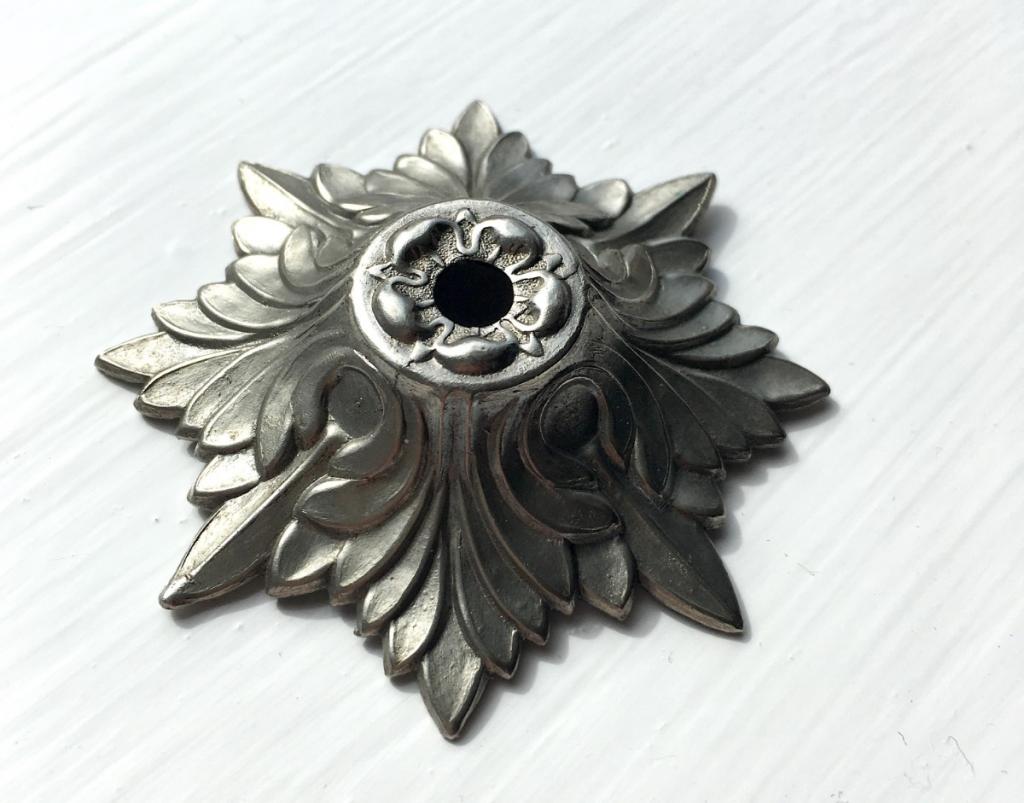-
Posts
65 -
Joined
-
Last visited
Content Type
Profiles
Forums
Blogs
Gallery
Events
Store
Everything posted by Peter Mc
-
Can anyone identify this force please? I only have bare details from a family member, but they believe these to be William and Edward Lloyd, born circa 1879-1882 in Worthen, Shrewsbury. They are thought to have died in the Great War. A brother emigrated to Canada in 1913 although I think these men are part of a UK constabulary. Can anyone shed any more light on the badge/collar/belt buckle badges? Thanks
-
A query for the helmet fittings experts please - This is the 'acanthus leaf' boss from a Dublin Metropolitan Police helmet. It is the first time I have seen one disassembled, as they are usually seen with the 'ball top' finial. I notice that the decoration on the boss extends up to the very top, which is usally hidden by the finial. It is also unventilated, which seems unusual. Does anyone know if these 'acanthus leaf' patterns were used on other helmets, police or military, and if so what would the other fittings have looked like? Did they allow for the additional decoration to be seen? Any ideas as to when these were first taken into general issue (again police/army if relevant)? I am sure this must have been a general pattern and not one specifically made for the D.M.P. - or am I wrong? There were a few posts on this 5 years ago, buried within another topic, but not the information I was looking for. I have asked the same question on the British Military Badge Forum a month ago, but received no responses. Hoping to have more luck here.
-
A very interesting thread. I have also been looking at the activities of the Special (Irish) Branch (S.I.B.) and in particular at the members of the Irish Constabulary involved in Port Duties, both during and after the Fenian dynamite conspiracies. You may be interested in this thread (click here) relating to the S.I.B. and which throws a few more names into play. Members of the R.I.C. present in British Ports and Cities can be found here. It's largely unstructured but is an attempt to record further names some of whom may well have worked alongside, or embeedded in, the SIB. Melville gets a fair bit of a mention from one of my members - Hope this adds a bit more to the mix.
-
I first came across this medal being offered for sale in 1992. Despite extensive searches, I was unable to identify 'C.M. Wood' as ever being associated with any of the Irish Police forces, clerical judiciary or office staff. The RCMP Museum was unable to help even with a full name (this was in the 90's so new archives may be available now). I have come across a further 10 'funnies'; all Visits 1911, some engraved to the MPSC, Gdn Hrs, Stoke on Trent Police, others unnamed but with named military medals. I have a feeling some of these men may have provided services in the St Johns Ambulance at the time, but this is only a speculation. The RIC did have a Colonial Policing training school and it is possible that men were present there, but usually these would have been of commissioned or NCO ranks. Again, I cannot place any of my '11 funnies' as positively being in Ireland at that time.
-
Hello IMP. I haven’t got any images myself but I recall some years back looking for some, and indeed found some either online or in old copies of the RUC Gazette. Sadly I didn’t save them. Most of the band photos are of the Pipe Band and they are seen wearing highland dress or greens usually. If I come across them again I will update this thread. When you say a different colour, could that be slight shade variations due to the dye manufacturing process?
-
Cheers Mike! I got alerted to this via an email notification. The images are missing due to Photobuckets change in policy on third party image hosting, which has affected millions of users worldwide - and some 2500 broken image links in my case. There is a fix I can apply (or repost the photos) but I need to be able to edit my own posts on this site, and that functionality (editing) seems to become locked after a period of time. Perhaps an admin can unlock it for me. Nice rattle you just recently posted. I don't know if you ever give these a 'twirl' to hear the sound - I'm reluctant to do it on mine as the wood is so aged now - although I did slowly rotate it once. P.S. I've applied the 'fix' to my own site so you can view the same images here: http://irishconstabulary.com/topic/1364#.WYrFEq2ZOMI
-
By way of comparison, here is one from the Irish police: The earliest known form of communication between constables was the police 'rattle', carried in the tail of the coat and used to summon help. It was effective to about 500 yards and was in use from the 1840's until around 1880; individual forces replacing the rattle with the whistle from about 1860 onwards. This example was issued to the Irish police and bears the crest of the Constabulary of Ireland, together with 'KILm XI', perhaps a reference to a parish watch. It is a rare and possibly unique reminder of the earliest years of the Irish constabulary. The force crest of the Constabulary of Ireland - Marked 'Kilm XI' -
-
That's not an RIC crest, but a set of initials that looks like RJC. Even if it were RIC I would expect it to be stamped with a rack number as well. Not a police firearm imo.
-
That is very interesting dksgiggs. Can you put up a photo of the carbine and a close up of the crest? What is the serial number? PM me if preferred.
-
This is the ISM awarded to John Code, Royal Irish Constabulary Office, Dublin, 1903. This came in an unnamed box (although this box may be a replacement). Also shown is the ISM awarded to Frederick Hamilton, Royal Irish Constabulary Office, Dublin, 1908; together with his two Visit to Ireland medals. As you can see it came in a named box of issue.
-

Persia - Order of the Lion and the Sun
Peter Mc replied to drclaw's topic in Middle East & Arab States
Incredible! Thanks Nick and Markus, you've opened my eyes to an order I'd never really looked at in detail before. I believe it was awarded at the Palace is Ispahan along with a 'Firman?' and the court poet recited an ode in Swifte's honour. -

Persia - Order of the Lion and the Sun
Peter Mc replied to drclaw's topic in Middle East & Arab States
Could anyone help me with finding some images of the 2nd Class Order of the Lion and Sun circa 1900? I know is that the the insignia of the 2nd Class of the Imperial Persian Order of the Lion and Sun was awarded to either Ernest Godwin Meade Swifte or Lathom Coddington Swifte (the records are unclear), who was at the time based in the Imperial Palace in Ispahan and was Equerry to the brother of the Shah of Persia. Another report says he (either Ernest of Lathom) was Equerry to the Shah's children - so there is a chance that both brothers were there at the same time. E G M Swifte received the order Feb 1900 (London Gazette 14 June 1901), and what I'm looking for is images of the order as at that date - I don't know if the insignia changed over the years. Was the insignia just a breast badge or was it a neck badge also? Many thanks -
Timo, I believe the medallion you refer to was just one of a number of commercially made variants offered for sale, or purchased in bulk by civic bodies to issue at the event. For example, during the 1900 Visit, thousands of schoolchildren were given a medal when attending Phoenix Park. These sometimes appear on the market as 'gallantry' medals as they have 'To commemorate Irish valour' on the reverse. The sharp eyed amongst you wil have noticed my deliberate mistake in the 1911 article further up. It was of course Qheen Mary who accompanied George, not Alexandra.
-
The Medal To commemorate the Royal Visit to Ireland of Queen Victoria in 1900 and that of King Edward VII in 1903, special bronze medals were struck and issued to Irish Police Forces on duty at those times. A silver medal was issued in recognition of the Visit of King George V to Ireland in July 1911 and was notified in the Royal Irish Constabulary Lists as follows: MEDAL COMMEMORATIVE OF THE VISIT OF KING GEORGE V TO IRELAND IN 1911 By Command of His Majesty a silver Commemorative Medal was issued to all Officers and Men of the Royal Irish Constabulary, and of the Dublin Metropolitan Police, who were then on duty in Dublin. The Medal is also held by the Members of the Civil Service Staffs of the Royal Irish Constabulary and Dublin Metropolitan Police Offices, Dublin Castle. The ribbon of the 1911 Visit Medal is dark green flanked by two red stripes, reflecting the colours of the RIC. It was designed by Sir Edgar Bertram Mackennal, whose initial 'B.M.' appear on the lower right front. Numbers Issued Based on Royal Mint records (MINT 20/468) the actual distribution of the medals was as follows: Royal Irish Constabulary - 1022 RIC Office Staff - 24 Dublin Metropolitan Police - 1314 DMP Office Staff - 4 St John Ambulance Brigade - 92 Kingstown Harbour Police - 11 Phoenix Park and St Stephens Green Police - 10 TOTAL - 2477 764 yards of ribbon was purchased from Messrs Redmayne at a cost of £36/12s/2d; and the weight of the silver bullion used in the manufacture of the medals was 2631.12 ozs. The order was completed on the 28th June 1912 Details of the Royal Visit King George V, Queen Alexandra and their entourage arrived in the Royal Yachts Victoria & Albert and Alexandra, escorted by the cruisers Cochrane and Carnarvon, together with ships of the First and Second Battle Squadrons and Second and Third Cruiser Squadrons of the Home Fleet. They arrived at Kingstown Harbour (now Dun Laoghaire) on the evening of July 7th where they lay at anchor for the evening. 27 ships in all formed the Naval Review and the entire Fleet was illuminated overnight. The Royal Party landed on Irish soil at 10:30am on the 8th July, and then traveled to Dublin Castle. At Ballsbridge, they were met by Assistant Inspector-General W A O'Connell, with his Adjutant Frederick R St Lawrence Tyrell, Riding Master Major Richard Edwin Odlum, DI George D'Urban Rodwell and DI Gilbert N Potter, with 200 men and the Band of the Royal Irish Constabulary. The procession was then led by the Mounted Force into Dublin Castle. That afternoon the King and Queen opened the new Royal College of Science (now part of Government Buildings) and visited Trinity College and the Phoenix Park racecourse. Here they inspected a Guard of Honor of 200 RIC plus band, under County Inspector W.H.R. Heard. It was reported that the King enquired of Constable Francis McCready (60123) of the Tyrone Force as to his Royal Humane Society medal, who told him it was for saving a woman's life from fire in Cookstown in 1911. On July 10th the King visited Maynooth College. Apparently racing was high on the agenda for on the 10th July the King attended Leopardstown racecourse. On the 11th, the King and Queen inspected the RIC in front of the Vice Regal Lodge in Phoenix Park. 17 officers and 394 men (including 40 members of the Mounted Force) under the command of C.I. Heard were present. King George V left Ireland on the 12th July. The visit of Queen Elizabeth on May 17th 2011, nearly 100 years later, brings the British Monarch back to the 26 Counties in an official capacity for the first time since Independence. Medal distribution The Visit to Ireland medals were distributed to the RIC at the end of July 1912, at a special parade in the Phoenix Park Depot. Unlike the 1900 and 1903 Visit medals, they did not come with a suspension clasp and would have had to be sewn directly onto the tunic. Fortunately the Armourer Sergeant was able to procure clasps – it is not known if members of the force had to pay for these – and these are occasionally found with the original ribbons. To augment the RIC and DMP constabularies during the Royal Visit, 200 extra men were drafted in from outlying counties and a further cohort provided from Belfast. St John Ambulance Brigade The King granted the right to wear the medal to those members of the St John Ambulance on duty during his stay. These medals were presented on Thursday 18 July 1912 in Lord Iveagh's gardens, St Stephens Green by Mr Justice Ross. The corps was under the command of Dr Lumsden, St James Gate Division. St James Gate Division – 53 officers and men Messrs Jacobs Division – 17 officers and men City of Dublin Division – 12 officers and men City of Dublin Nursing Division – Lady Superintendent and 5 nurses
-

The Peaked or Visor Cap
Peter Mc replied to Stuart Bates's topic in Great Britain: Militaria: Badges, Uniforms & Equipment
The peaked or 'German' cap as it was known in the Royal Irish Constabulary was introduced in October 1900 as replacement for the round pill-box cap. Of course I'm only talking about the RIC here but they generally followed the British Army standards as 'fast followers'. -
Very nice Mervyn and a nice untampered condition. I wonder are there any markings to the butt? Have you ever managed to shoot this weapon at all?
-
Sadly some of the RIC items pictured above have been stolen within the past month, following a smash and grab raid at the museum in Cultra. No doubt they will appear on the market soon so anyone offered such items should be aware they are security marked, and should inform the PSNI or their local police force. See also this BBC News link.
-
The Lee Enfield RIC Carbines (part 1 of 2) A Lee Enfield carbine adapted for the RIC A LEC Mk1* Carbine, 20.5in barrel. EV11R Crown dated 1903, probably over earlier stamp as barrel is Victorian.
-
The Lee Enfield RIC Carbines (part 1 of 2) Lee Enfield Mk1* carbines or Lee Metford cavalry carbines converted to Enfield rifling; 21 inch barrel, nose cap adapted to take the Pattern 88 knife bayonet. Small six-round magazines. 11,000 were supplied by the War Office as a free issue to the RIC between March 1904 and 1914. The new carbine was first issued to the Reserve Force at Dublin's Phoenix Park Depot in March 1904, before being distributed across the county forces. It replaced the Martini Henry carbine and at the same time replaced the existing long bayonet with the shorter knife pattern. By July 1904 the new rifle had been issued to counties Cavan and Carlow, and special training regarding the mechanism of the new rifles had been given to the RIC Musketry Instructors. In January 1905 Kings county had been supplied, and it was noted that Morris Tubes had been privately purchased by some of the men for practice. County Monaghan did not take possession of the carbines until April 1905. In September 1920 the RIC wrote to the Ministry of Munitions of War to communicate their desire to sell as scrap approximately 10,000 of these carbines, which were to be replaced with the modern SMLE rifle. They were shipped to the Royal Small Arms Factory at Enfield Lock around November or December 1920, together with around 1.1 million rounds of MkVI ammunition (ref: National Archives file MUN 4/6028). The estimate for scrappage was 5d each, or £1 if sold (for LE carbines) or 10 shillings each (the Lee Metford carbines). I am led to believe that some of these carbines were taken into use by the South African Prison Service. A Lee Metford cavalry carbine converted to Enfield rifling 21" brl with Enfield 5 groove rifling, military proofs at breech. Full walnut stock, nose cap with bayonet lug to accept the P88 knife bayonet. Butt with brass disk stamped 3.'04 R.I.C.1094. This specimen made up from a Lee Metford cavalry carbine which was re-barrelled. Vg o/a cond with high % finish, shooting grade bore. I have fired this weapon many times and it has a kick like a mule!
-
Martini Henry Royal Irish Constabulary carbine A Martini Henry Mark II carbine of .45/577 calibre, with Royal Irish Constabulary markings (R.I.C. 2457). These were shortened versions of the Martini Henry rifle, now sporting 21 inch barrels. Action stamped with the Enfield VR cipher and dated 1885. This model with an original wide black leather sling. The Martini Henry was introduced to the RIC around June 1899, with the final batch being issued to the Belfast police in June 1900. It replaced the Snider carbine, of which 12,000 were recalled. As part of the cost saving practices for which the Irish authorities were renowned, the bayonets previously used with the Snider rifles were also recalled, shipped to England to be rebushed, then finally re-fitted to the Martinis and re-numbered at the Constabulary Armoury. The Martini Henry saw only a limited period of service with the RIC, being replaced by the Lee-Enfield carbine from 1904.
-
A nice looking musket Mervyn and is that a sling swivel forward of the trigger guard? What are the markings on your musket and bayonet?


